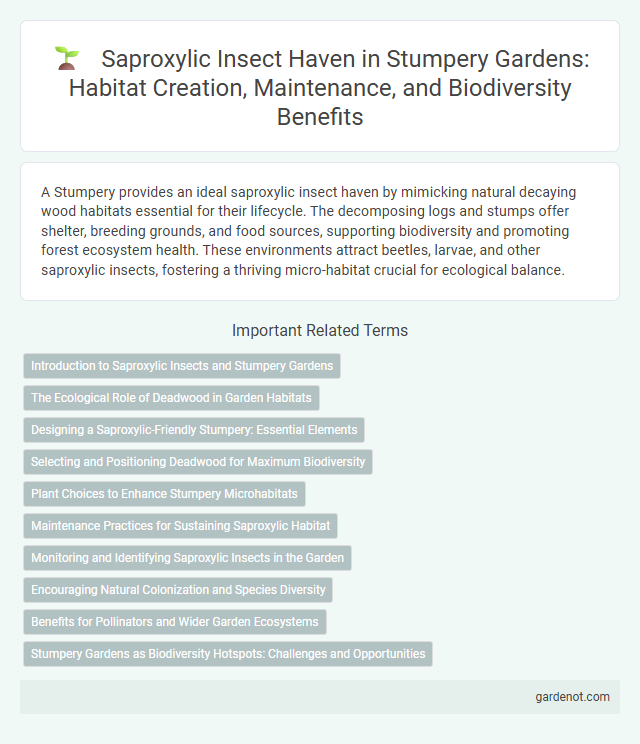A Stumpery provides an ideal saproxylic insect haven by mimicking natural decaying wood habitats essential for their lifecycle. The decomposing logs and stumps offer shelter, breeding grounds, and food sources, supporting biodiversity and promoting forest ecosystem health. These environments attract beetles, larvae, and other saproxylic insects, fostering a thriving micro-habitat crucial for ecological balance.
Introduction to Saproxylic Insects and Stumpery Gardens
Saproxylic insects depend on decaying wood and dead plant material to complete their life cycles, playing a crucial role in forest ecosystems by aiding nutrient recycling and providing food for other wildlife. Stumpery gardens mimic natural wood decay processes by arranging dead tree stumps, logs, and branches to create habitats rich in fungi, mosses, and saproxylic insects. These specialized gardens support biodiversity, offering a sanctuary for rare beetles, larvae, and wood-dependent invertebrates essential for maintaining ecological balance.
The Ecological Role of Deadwood in Garden Habitats
Deadwood in garden habitats serves as a vital saproxylic insect haven, supporting a diverse range of species such as beetles, larvae, and fungi that depend on decaying wood for survival. This ecological niche enhances biodiversity by providing essential resources for nutrient cycling and habitat complexity. Maintaining stumperies with varied deadwood types promotes the conservation of these specialized insects, which play key roles in decomposing organic matter and sustaining garden ecosystem health.
Designing a Saproxylic-Friendly Stumpery: Essential Elements
Designing a saproxylic-friendly stumpery involves incorporating diverse decaying wood types and varying moisture levels to create ideal habitats for saproxylic insects such as beetles and woodlice. Essential elements include maintaining fallen logs, tree stumps, and branches in shaded, undisturbed areas to support the full life cycle of these insects. Integrating native plant species and ensuring minimal soil disturbance enhance microhabitats critical for saproxylic biodiversity and ecological balance.
Selecting and Positioning Deadwood for Maximum Biodiversity
Selecting deadwood with varied decay stages and diverse tree species enhances the saproxylic insect habitat within a stumpery. Positioning logs and stumps in shaded, moist microhabitats supports optimal fungal growth vital for saproxylic insect life cycles. Creating structural complexity by layering wood and incorporating branches increases niche availability, promoting maximum biodiversity.
Plant Choices to Enhance Stumpery Microhabitats
Selecting native, decaying hardwoods like oak and beech enhances saproxylic insect diversity in stumperies by providing essential nourishment and breeding grounds. Incorporating mosses, ferns, and shade-tolerant understory plants fosters humidity and structural complexity, crucial for insect microhabitats. Strategic layering of logs and stumps with diverse plant species creates a stable, nutrient-rich environment that supports saproxylic insect life cycles effectively.
Maintenance Practices for Sustaining Saproxylic Habitat
Regular removal of invasive species and controlled pruning maintain the delicate balance of moisture and light essential for saproxylic insects in a stumpery. Retaining deadwood and decaying logs preserves critical breeding and feeding sites, supporting biodiversity. Periodic monitoring of microhabitat conditions ensures the long-term viability of saproxylic insect populations within the habitat.
Monitoring and Identifying Saproxylic Insects in the Garden
Monitoring and identifying saproxylic insects in a stumpery involves regular inspection of decaying wood habitats to document species diversity and population health. Utilizing tools such as insect traps, photographic records, and expert guides enhances accuracy in recognizing key indicator species like beetles and wood-boring flies. Data collected supports conservation efforts by tracking ecosystem dynamics and informing habitat management strategies.
Encouraging Natural Colonization and Species Diversity
Stumperies provide an ideal saproxylic insect haven by creating a microhabitat rich in decaying wood, fostering natural colonization and enhancing species diversity. The diverse structure of stumperies supports fungal growth and moisture retention, which attract a wide range of saproxylic beetles, flies, and other invertebrates critical for nutrient recycling. Promoting natural colonization through minimal disturbance and using native tree stumps ensures a thriving ecosystem that sustains saproxylic communities and overall biodiversity.
Benefits for Pollinators and Wider Garden Ecosystems
A stumpery provides an essential saproxylic insect haven by mimicking natural deadwood habitats, which supports diverse pollinator populations such as solitary bees and beetles. These insects facilitate plant pollination, enhancing garden biodiversity and resilience against pests. The presence of saproxylic insects also contributes to nutrient cycling, enriching soil health and promoting robust growth across wider garden ecosystems.
Stumpery Gardens as Biodiversity Hotspots: Challenges and Opportunities
Stumpery gardens serve as vital saproxylic insect havens, fostering biodiversity by providing decaying wood habitats essential for these specialist species. Their role as biodiversity hotspots is challenged by habitat fragmentation and declining deadwood availability, yet opportunities arise through targeted conservation efforts and public education on habitat value. Enhancing stumpery microhabitats supports saproxylic populations, contributing to ecosystem health and resilience in garden ecosystems.
Saproxylic insect haven Infographic

 gardenot.com
gardenot.com